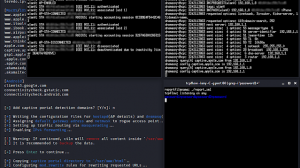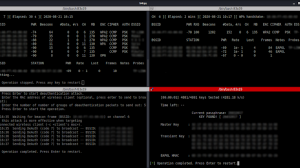The Rogue Toolkit is an extensible toolkit aimed at providing penetration testers an easy-to-use platform to deploy software-defined Access Points (AP) for the purpose of conducting penetration testing and red team engagements. By using Rogue, penetration testers can easily perform targeted evil twin attacks against a variety of wireless network types.
Rogue was originally forked from s0lst1c3’s eaphammer project. The fundamental idea of the Rogue toolkit was to leverage the core concept of the eaphammer project in an alternative manner to allow for flexibility, integration and adaption to future changes to the 802.11 standards and supporting tools. Rogue is suited for the the following cases:
- Compromising corporate accounts to be later used in impersonation attacks to gain access to corporate wireless networks.
- To subvert network protections, such as captive portals or client to client isolation, to be able to target and compromise connected wireless devices and using compromised devices and credentials to pivot deeper into internal networks.
Supported Features
Automatic Channel Selection– The Rogue toolkit allows testers to leverage hostapd-wpe’s in-built Automatic Channel Selection (ACS) functionality to perform a scan of the surrounding frequencies to detect a clear channel for hostapd-wpe to utilise. ACS can be invoked by providing a value of 0 as the channel.- packet capturing – The Rogue toolkit leverages
tcpdumpto allow penetration testers to record the network traffic of their evil twin networks for record keeping purposes. karma– The Rogue toolkit can invoke hostapd-wpe with in-built karma support enabled. When karma is enabled, the hostapd-wpe access point will respond to all 802.11 probe requests, not just for itself but for any requested ESSID. This feature allows the toolkit to draw in surrounding client devices that are probing for known networks and to begin to attack these devices.ESSID Masking– The Rogue toolkit also supports ESSID cloaking, allowing testers to set the value of the SSID field in 802.11 frames to 0. This allows for stealthier attacks, especially when performing karma-based attacks.network bridging– When the Rogue toolkit is launched, it will also launch an instance ofisc-dhcp-serverwhich provides thehostapd-wpewireless network with DHCP. However, by default this network is isolated from the internet or any other network the attack platform is also connected too. By using the--internetargument, a tester can bridge the rogue network with another network. This allows Rogue to provide seamless access to resources expected by the connected victims and enable follow up network attacks to compromise connected victim credentials.- Rogue currently supports the following IEEE 802.11 protocols:
- 802.11b
- 802.11g
- 802.11n (2.4GHz/5GHz)
- 802.11a
- Rogue currently supports the following wireless authentication types:
- open
- wep
- wpa-psk(1/2)
- wpa2-enterprise
x.509 Certificate Generation– Certificates are required by the Rogue toolkit to use many of the supported EAP-types when deploying WPA2-Enterprise based wireless networks.- The toolkit has been extended to support for
sslsplit. This allows testers to automated perform SSL termination to be able intercept credentials exchanged over an encrypted channel. - The Rogue toolkit uses
freeradius-wpeas an external Radius server when deploying wpa2-enterprise-based networks. An external Radius server is used instead of the integrated Radius server withinhostapd-wpe. This allows for wider ranges of scenarios to be supported and support more EAP-types:- ttls
- tls
- peap
- md5
- pwd
- gtc
- leap
- The Rogue toolkit include a website cloning capabilities, using
httrack, allowing testers to clone a website to be used in later attacks. The idea behind this capability is to allow the tester to clone captive portals or other sites of interest. Once cloned, the site can be served to connected victims through external DNS spoofing with seeded web hooks for the several hostile portal attacks. - The toolkit has been extended to support hostile portal attacks. After cloning a website, the Rogue toolkit can insert a browser hook into a cloned page to be served to the victim. When the modified page is next view, the victim’s browser will be hooked by the supported framework. The Rogue toolkit currently supports the following hostile portal modes:
- BeEF Framework
- responder
Install
This toolkit has been designed and tested on Kali Linux.
git clone https://github.com/InfamousSYN/rogue.git cd ./rogue python install.py
Dependencies
Software
- hostapd-wpe
- freeradius-wpe
- isc-dhcp-server
- httrack
- sslsplit
- responder
- be3f framework
- apache2/httpd
- openssl
- tcpdump
Python libraries
- tqdm
- netifaces





















Add Comment